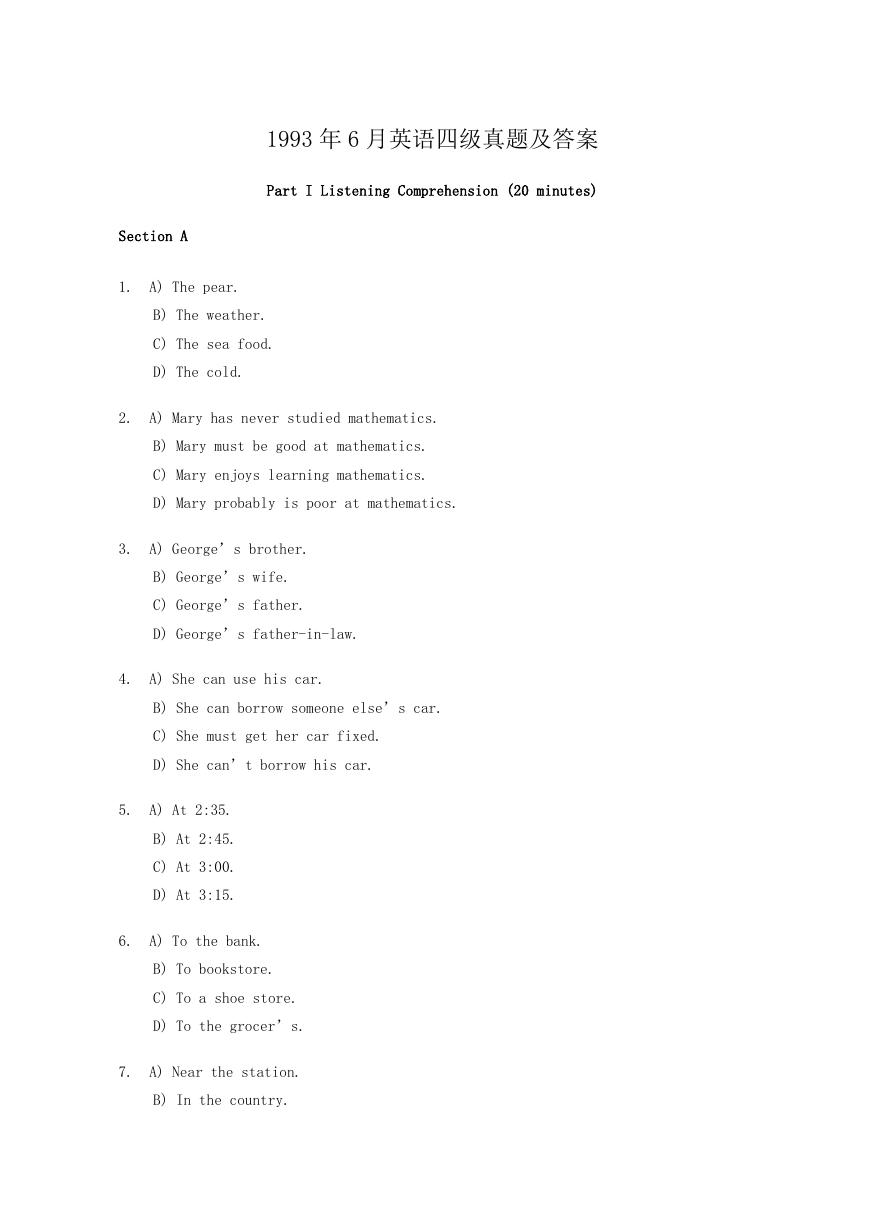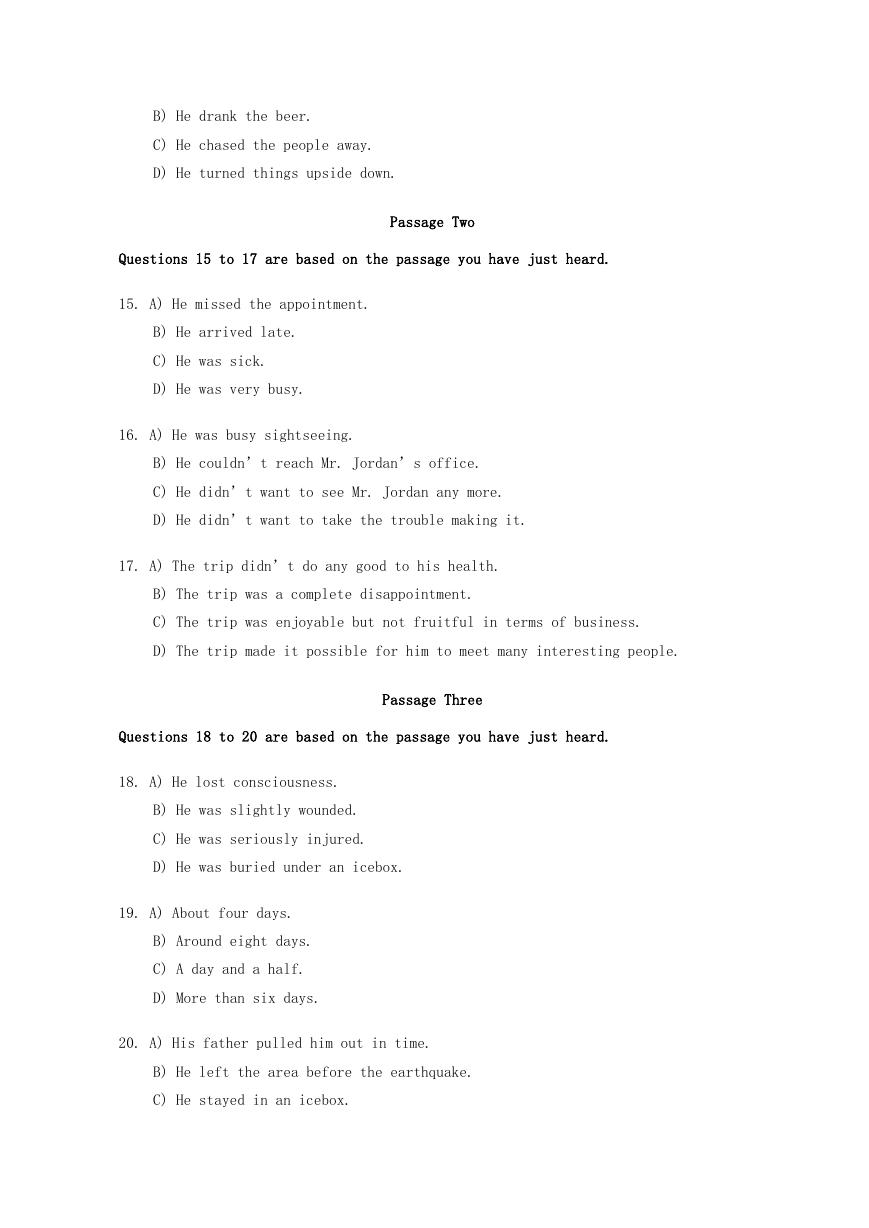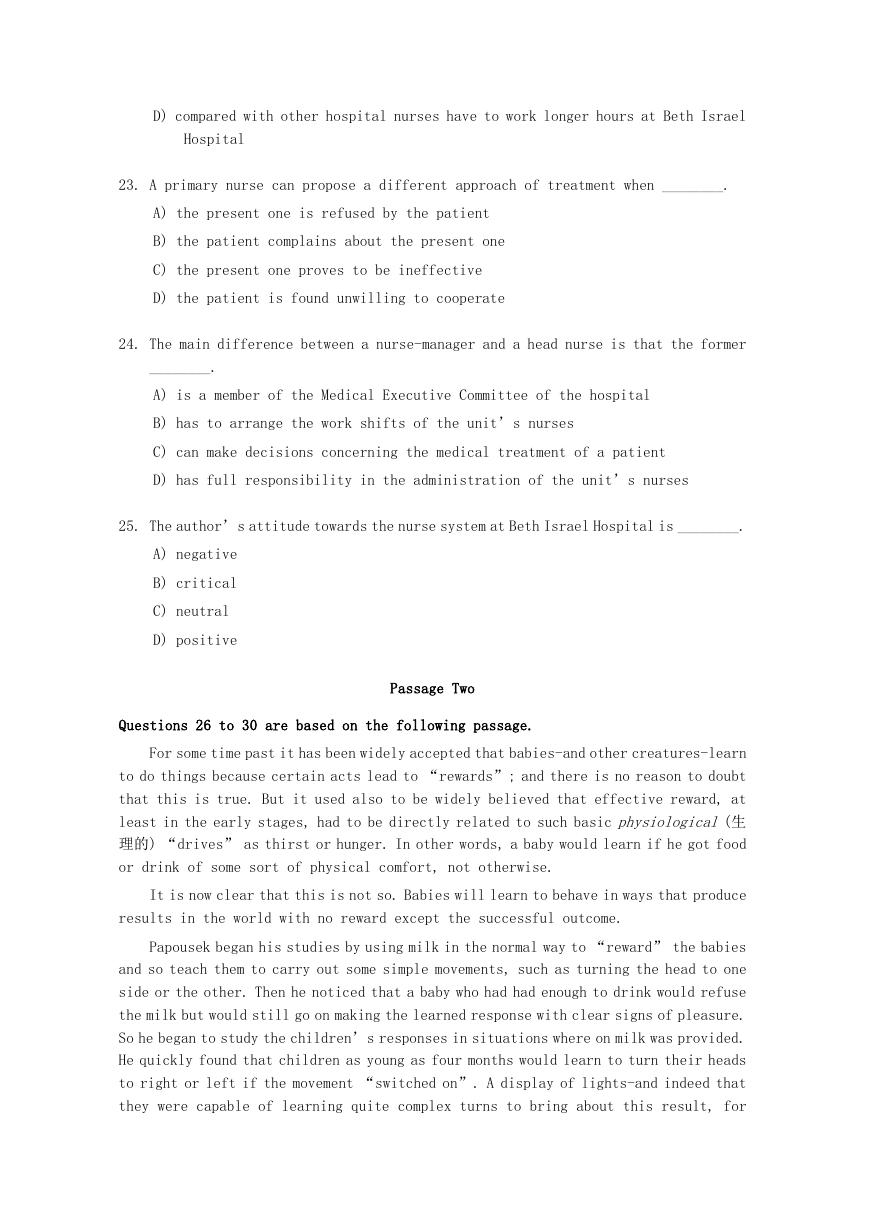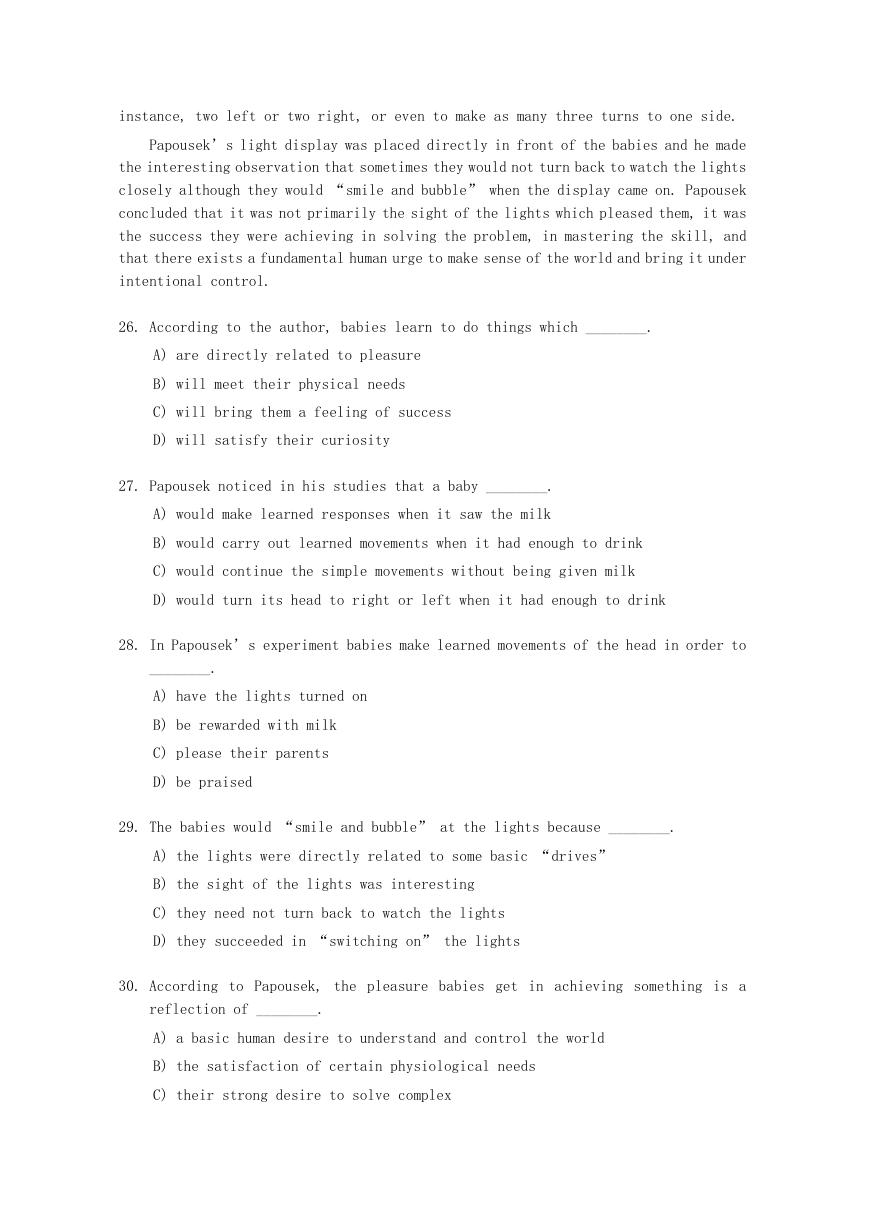1993 年 6 月英语四级真题及答案
Part I Listening Comprehension (20 minutes)
Section A
1.
A) The pear.
B) The weather.
C) The sea food.
D) The cold.
2.
A) Mary has never studied mathematics.
B) Mary must be good at mathematics.
C) Mary enjoys learning mathematics.
D) Mary probably is poor at mathematics.
3.
A) George’s brother.
B) George’s wife.
C) George’s father.
D) George’s father-in-law.
4.
A) She can use his car.
B) She can borrow someone else’s car.
C) She must get her car fixed.
D) She can’t borrow his car.
5.
A) At 2:35.
B) At 2:45.
C) At 3:00.
D) At 3:15.
6.
A) To the bank.
B) To bookstore.
C) To a shoe store.
D) To the grocer’s.
7.
A) Near the station.
B) In the country.
�
C) In the city.
D) Near her work place.
8.
A) At a cigarette store.
B) At a bus station.
C) At a gas station.
D) At Aunt Mary’s.
9.
A) From upstairs.
B) From next door.
C) From the Nelsons’ house.
D) From the back door.
10. A) The choice of course.
B) A day course.
C) An evening course.
D) Their work.
Section B
Questions 11 to 14 are based on the following passage you have just heard.
Passage One
11. A) They haven’t reached a decision yet.
B) They have decided to go hunting bears.
C) They want to go hunting camping.
D) They want to go exploring the country.
12. A) Susie.
B) Tom.
C) The speaker.
D) The speaker’s husband.
13. A) They chased the bear away.
B) They stayed outside the tent and did nothing.
C) They climbed up a tree.
D) They put some honey outside for the bear to eat.
14. A) He ate the honey.
�
B) He drank the beer.
C) He chased the people away.
D) He turned things upside down.
Questions 15 to 17 are based on the passage you have just heard.
Passage Two
15. A) He missed the appointment.
B) He arrived late.
C) He was sick.
D) He was very busy.
16. A) He was busy sightseeing.
B) He couldn’t reach Mr. Jordan’s office.
C) He didn’t want to see Mr. Jordan any more.
D) He didn’t want to take the trouble making it.
17. A) The trip didn’t do any good to his health.
B) The trip was a complete disappointment.
C) The trip was enjoyable but not fruitful in terms of business.
D) The trip made it possible for him to meet many interesting people.
Questions 18 to 20 are based on the passage you have just heard.
Passage Three
18. A) He lost consciousness.
B) He was slightly wounded.
C) He was seriously injured.
D) He was buried under an icebox.
19. A) About four days.
B) Around eight days.
C) A day and a half.
D) More than six days.
20. A) His father pulled him out in time.
B) He left the area before the earthquake.
C) He stayed in an icebox.
�
D) Their house escaped the earthquake.
Part II Reading Comprehension (35 minutes)
Passage One
Questions 21 to 25 are based on the following passage.
Nursing at Beth Israel Hospital produces the best patient care possible. If we are
to solve the nursing shortage (不足), hospital administration and doctors everywhere
would do well to follow Beth Israel’s example.
At Beth Israel each patient is assigned to a primary nurse who visits at length
with the patient and constructs a full-scale health account that covers everything from
his medical history to his emotional state. Then she writes a care plan centered on
the patient’s illness but which also includes everything else that is necessary.
The primary nurse stays with the patient through his hospitalization, keeping track
with his progress and seeking further advice from his doctor. If a patient at Beth Israel
is not responding to treatment, it is not uncommon for his nurse to propose another
approach to his doctor. What the doctor at Beth Israel has in the primary nurse is a
true colleague.
Nursing at Beth Israel also involves a decentralized ( 分 散 的 ) nursing
administration; every floor, every unit is a self-contained organization. There are
nurse-managers instead of head nurses; in addition to their medical duties they do all
their
salary
recommendations. Each unit’s nurses decide among themselves who will work what shifts
and when.
dismissing, employee
advising,
and
they make
own
hiring
and
Beth Israel’s nurse-in-chief ranks as an equal with other vice presidents of the
hospital. She also is a member of the Medical Executive Committee, which is most
hospitals includes only doctors.
21. Which of the following best characterizes the main feature of the nursing system
at Beth Israel Hospital?
A) The doctor gets more active professional support from the primary nurse.
B) Each patient is taken care of by a primary nurse day and night.
C) The primary nurse writes care plans for every patient.
D) The primary nurse keeps records of the patient’s health conditions every day.
22. It can be inferred from the passage that ________.
A) compared with other hospitals nurse at Beth Israel Hospital are more patient
B) in most hospitals patient care is inadequate from the professional point of
view
C) in most hospital nurse get low salaries
�
D) compared with other hospital nurses have to work longer hours at Beth Israel
Hospital
23. A primary nurse can propose a different approach of treatment when ________.
A) the present one is refused by the patient
B) the patient complains about the present one
C) the present one proves to be ineffective
D) the patient is found unwilling to cooperate
24. The main difference between a nurse-manager and a head nurse is that the former
________.
A) is a member of the Medical Executive Committee of the hospital
B) has to arrange the work shifts of the unit’s nurses
C) can make decisions concerning the medical treatment of a patient
D) has full responsibility in the administration of the unit’s nurses
25. The author’s attitude towards the nurse system at Beth Israel Hospital is ________.
A) negative
B) critical
C) neutral
D) positive
Passage Two
Questions 26 to 30 are based on the following passage.
For some time past it has been widely accepted that babies-and other creatures-learn
to do things because certain acts lead to “rewards”; and there is no reason to doubt
that this is true. But it used also to be widely believed that effective reward, at
least in the early stages, had to be directly related to such basic physiological (生
理的) “drives” as thirst or hunger. In other words, a baby would learn if he got food
or drink of some sort of physical comfort, not otherwise.
It is now clear that this is not so. Babies will learn to behave in ways that produce
results in the world with no reward except the successful outcome.
Papousek began his studies by using milk in the normal way to “reward” the babies
and so teach them to carry out some simple movements, such as turning the head to one
side or the other. Then he noticed that a baby who had had enough to drink would refuse
the milk but would still go on making the learned response with clear signs of pleasure.
So he began to study the children’s responses in situations where on milk was provided.
He quickly found that children as young as four months would learn to turn their heads
to right or left if the movement “switched on”. A display of lights-and indeed that
they were capable of learning quite complex turns to bring about this result, for
�
instance, two left or two right, or even to make as many three turns to one side.
Papousek’s light display was placed directly in front of the babies and he made
the interesting observation that sometimes they would not turn back to watch the lights
closely although they would “smile and bubble” when the display came on. Papousek
concluded that it was not primarily the sight of the lights which pleased them, it was
the success they were achieving in solving the problem, in mastering the skill, and
that there exists a fundamental human urge to make sense of the world and bring it under
intentional control.
26. According to the author, babies learn to do things which ________.
A) are directly related to pleasure
B) will meet their physical needs
C) will bring them a feeling of success
D) will satisfy their curiosity
27. Papousek noticed in his studies that a baby ________.
A) would make learned responses when it saw the milk
B) would carry out learned movements when it had enough to drink
C) would continue the simple movements without being given milk
D) would turn its head to right or left when it had enough to drink
28. In Papousek’s experiment babies make learned movements of the head in order to
________.
A) have the lights turned on
B) be rewarded with milk
C) please their parents
D) be praised
29. The babies would “smile and bubble” at the lights because ________.
A) the lights were directly related to some basic “drives”
B) the sight of the lights was interesting
C) they need not turn back to watch the lights
D) they succeeded in “switching on” the lights
30. According to Papousek, the pleasure babies get in achieving something is a
reflection of ________.
A) a basic human desire to understand and control the world
B) the satisfaction of certain physiological needs
C) their strong desire to solve complex
�
D) a fundamental human urge to display their learned skills
Passage Three
Questions 31 to 35 are based on the following passage.
When a consumer finds that an item she or he bought is faulty or in some way does
not live up to the manufacturer’s claim for it, the first step is to present the warranty
(保单), or any other records which might help, at the store of purchase. In most cases,
this action will produce results. However, if it does not, there are various means the
consumer may use to gain satisfaction.
A simple and common method used by many consumers is to complain directly to the
store manager. In general, the “higher up” the consumer takes his or her complaint,
the faster he or she can expect it to be settled. In such a case, it is usually settled
in the consumer’s favor, assuming he or she has a just claim.
Consumers should complain in person whenever possible, but if they cannot get to
the place of purchase, it is acceptable to phone or write the complaint in a letter.
Complaining is usually most effective when it is done politely but firmly, and
especially when the consumer can demonstrate what is wrong with the item in questions.
If this cannot be done, the consumer will succeed best by presenting specific
information as to what is wrong, rather than by making general statements. For example,
“The left speaker does not work at all and the sound coming out of the right one is
unclear” is better than “This stereo (立体声音响) does not work.”
The store manager may advise the consumer to write to the manufacturer. If so, the
consumer should do this, stating the complaint as politely and as firmly as possible.
But if a polite complaint does not achieve the desired result, the consumer can go a
step further. She or he can threaten to take the seller to court or report the seller
to a private or public organization responsible for protecting consumers’ rights.
31. When a consumer finds that his purchase has a fault in it, the first thing he should
do is to ________.
A) complain personally to the manager
B) threaten to take the matter to court
C) write a firm letter of complaint to the store or purchase
D) show some written proof of the purchase to the store
32. If a consumer wants a quick settlement of his problem, it’s better to complain
to ________.
A) a shop assistant
B) the store manager
C) the manufacturer
D) a public organization
�
33. The most effective complaint can be made by ________.
A) showing the faulty item to the manufacturer
B) explaining exactly what is wrong with the item
C) saying firmly that the item of poor quality
D) asking politely to change the item
34. The phrase “live up” (Para. 1, Line 2) in the context means ________.
A) meet the standard of
B) realize the purpose of
C) fulfill the demands of
D) keep the promise of
35. The passage tells us ________.
A) how to settle a consumer’s complaint about a faulty item
B) how to make an effective complaint about a faulty item
C) how to avoid buying a faulty item
D) how to deal with complaints from customers
Passage Four
Questions 36 to 40 are based on the following passage.
If women are mercilessly exploited(剥削) year after year, they have only themselves
to blame. Because they tremble at the thought of being seem in public in clothes that
are out of fashion, they are always taken advantage of by the designers and the big
stores. Clothes which have been worn only a few times have to be put aside because of
the change of fashion. When you come to think of it, only a woman is capable of standing
in front of a wardrobe(衣柜) packed full of clothes and announcing sadly that she has
nothing to wear.
Changing fashions are nothing more than the intentional creation of waste. Many
women spend vast sums of money each year to replace clothes that have hardly been worn.
Women who cannot afford to throw away clothing in this way, waste hours of their time
altering the dresses they have. Skirts are lengthened or shortened; neck-lines are
lowered or raised, and so on.
No one can claim that the fashion industry contributes anything really important
to society. Fashion designers are rarely concerned with vital things like warmth,
comfort and durability(耐用). They are only interested in outward appearance and they
take advantage of the fact that women will put up with any amount of discomfort, as
long as they look right. There can hardly be a man who hasn’t at some time in his life
smiled at the sight of a woman shaking in a thin dress on a winter day, or delicately
picking her way through deep snow in high-heeled shoes.
When comparing men and men and women in the matter of fashion, the conclusions to
�
















 2023年江西萍乡中考道德与法治真题及答案.doc
2023年江西萍乡中考道德与法治真题及答案.doc 2012年重庆南川中考生物真题及答案.doc
2012年重庆南川中考生物真题及答案.doc 2013年江西师范大学地理学综合及文艺理论基础考研真题.doc
2013年江西师范大学地理学综合及文艺理论基础考研真题.doc 2020年四川甘孜小升初语文真题及答案I卷.doc
2020年四川甘孜小升初语文真题及答案I卷.doc 2020年注册岩土工程师专业基础考试真题及答案.doc
2020年注册岩土工程师专业基础考试真题及答案.doc 2023-2024学年福建省厦门市九年级上学期数学月考试题及答案.doc
2023-2024学年福建省厦门市九年级上学期数学月考试题及答案.doc 2021-2022学年辽宁省沈阳市大东区九年级上学期语文期末试题及答案.doc
2021-2022学年辽宁省沈阳市大东区九年级上学期语文期末试题及答案.doc 2022-2023学年北京东城区初三第一学期物理期末试卷及答案.doc
2022-2023学年北京东城区初三第一学期物理期末试卷及答案.doc 2018上半年江西教师资格初中地理学科知识与教学能力真题及答案.doc
2018上半年江西教师资格初中地理学科知识与教学能力真题及答案.doc 2012年河北国家公务员申论考试真题及答案-省级.doc
2012年河北国家公务员申论考试真题及答案-省级.doc 2020-2021学年江苏省扬州市江都区邵樊片九年级上学期数学第一次质量检测试题及答案.doc
2020-2021学年江苏省扬州市江都区邵樊片九年级上学期数学第一次质量检测试题及答案.doc 2022下半年黑龙江教师资格证中学综合素质真题及答案.doc
2022下半年黑龙江教师资格证中学综合素质真题及答案.doc